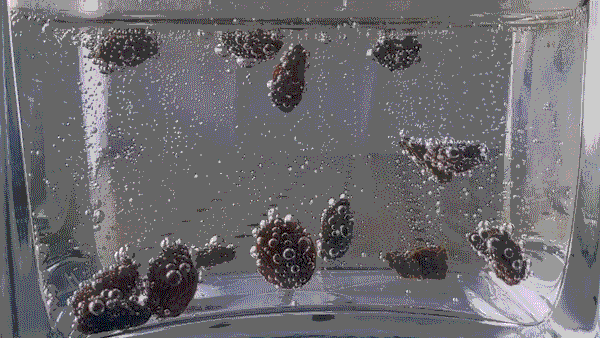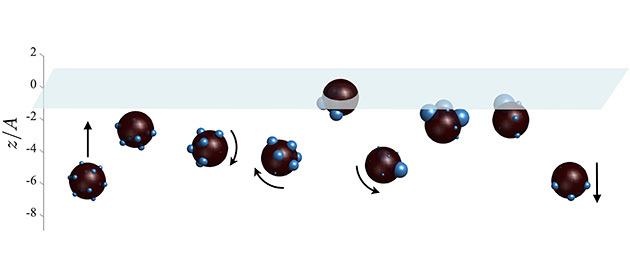What are the qualities of a good dancer? To Saverio Spagnolie, it’s not balance, flexibility or artistry — it’s oscillation.
“I would say the best dancers oscillate vertically with a high frequency and are tasteful enough to both ascend and descend with an elegant trajectory,” he says.
Then again, Spagnolie isn’t a dancer by trade, he’s a professor of mathematics. And he’s not studying ballerinas, he’s researching raisins. He drops them into sparkling water and watches as the bubbles help them boogie, bouncing up and down in the seltzer for a 30-minute show. According to his recent article, raisins are some of the best dancers around, and for years he’s been determined to find out why.

His research started six years ago at his home. Spagnolie was playing a game with his then-3-year-old daughter in the kitchen. He had just taught her about floating and sinking and was demonstrating this new knowledge by tossing random things into different fluids to watch them — you guessed it — float or sink. This is what Spagnolie calls “curiosity-driven learning,” and when they dropped handfuls of cashews into sparkling water, it led to a pretty puzzling phenomenon.
“All of a sudden we are faced with a very perplexing situation,” Spagnolie says. “They are not floating, nor are they sinking. What’s going on?”
The cashews were bouncing up and down — or dancing.
Naturally the discovery was exciting for Spagnolie’s daughter. But it was also particularly interesting to the professor, who specializes in studying the behavior of swimming organisms in fluids. He’s especially drawn to problems that involve many interacting bodies in complex environments. One such example is looking at the interactions of hundreds of bacteria swimming through mucus, a common and very complicated fluid.
“I wasn’t just seeing a cashew in sparkling water going up and down,” Spagnolie says. “I was seeing partial differential equations describing bubble growth and interfacial phenomena. I was seeing the motion of bodies pushing through a fluid and experiencing hydrodynamic drag. I was seeing the interaction of multiple bodies, and from there you can see some kind of equation that describes the statistics of many bodies experiencing a complex environment. I was just tickled, and I couldn’t help myself but to actually understand it.”
So, Spagnolie got to work. He learned that there’s a pastime in Argentina in which bargoers plop peanuts in beer for a similar effect. But it didn’t take long for him to discover that raisins are better dancers than cashews or peanuts. In fact, the nickname “dancing raisins” comes from Little League baseball players who throw raisins in Coke. And in the 1980s, the California Raisins Advisory Board launched a full commercial campaign featuring the fictional musical group, The California Raisins, singing and dancing to Marvin Gaye's "I Heard It Through the Grapevine."
With raisins as his new focal point, he started testing theories using 3D-printed versions of the dried grapes as a control for the experiments he conducted in the Applied Math, Engineering, and Physics (AMEP) Laboratory at UW–Madison. The lab is linked to the AMEP degree program, which trains undergraduate students for a wide range of research careers. Spagnolie worked closely with two students, Samuel Christianson and Carsen Grote, on the project. They investigated the importance of body rotation, gas concentration, and even surface wrinkles on the dancing.
So why do raisins dance? After years in the lab, Spagnolie finally has the answer. Here’s the simplified version: When immersed in carbonated water, raisins accumulate a dynamic field of bubbles around their surfaces. As gas is pulled from the water, the bubbles grow and coalesce, and these attached bubbles can lift the raisin upward against gravity. But once a raisin reaches the surface, the bubbles are cleaned off causing it to plummet. This starts the process anew, and it continues as long as the concentration of gas in the fluid supports it.

“There is a lot of time and effort between having a sense of what’s going on in a system, and understanding it deeply enough using mathematics to make accurate predictions,” Spagnolie noted.
You can read the full findings here. Or, for a gif-infused explanation, check out Spagnolie’s viral X thread.
“I think the reason it has taken off is that there are so many different layers of possible engagement,” Spagnolie says. “My 3-year-old loved this problem, you could explain it differently to someone in high school and they could get a different level of appreciation for it, and you can take a professor and get them to work for three years on it — because there’s something for everyone.”
